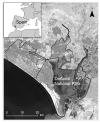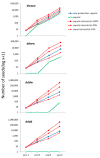Terrestrial Morphotypes of Aquatic Plants Display Improved Seed Germination to Deal with Dry or Low-Rainfall Periods
- PMID: 33920068
- PMCID: PMC8069061
- DOI: 10.3390/plants10040741
Terrestrial Morphotypes of Aquatic Plants Display Improved Seed Germination to Deal with Dry or Low-Rainfall Periods
Abstract
In temporary ponds, seed germination largely determines how well aquatic plant assemblages recover after dry periods. Some aquatic plants have terrestrial morphotypes that can produce seeds even in dry years. Here, we performed an experiment to compare germination patterns for seeds produced by aquatic and terrestrial morphotypes of Ranunculus peltatus subsp. saniculifolius over the course of five inundation events. During the first inundation event, percent germination was higher for terrestrial morphotype seeds (36.1%) than for aquatic morphotype seeds (6.1%). Seed germination peaked for both groups during the second inundation event (terrestrial morphotype: 47%; aquatic morphotype: 34%). Even after all five events, some viable seeds had not yet germinated (terrestrial morphotype: 0.6%; aquatic morphotype: 5%). We also compared germination patterns for the two morphotypes in Callitriche brutia: the percent germination was higher for terrestrial morphotype seeds (79.5%) than for aquatic morphotype seeds (41.9%). Both aquatic plant species use two complementary strategies to ensure population persistence despite the unpredictable conditions of temporary ponds. First, plants can produce seeds with different dormancy periods that germinate during different inundation periods. Second, plants can produce terrestrial morphotypes, which generate more seeds during dry periods, allowing for re-establishment when conditions are once again favorable.
Keywords: Callitriche brutia; Mediterranean wetlands; Ranunculus peltatus subsp. saniculifolius; germination; reproductive strategies; seeds; temporary ponds.
Conflict of interest statement
The authors declare no conflict of interest.
Figures





Similar articles
-
Hypomethylation of the aquatic invasive plant, Ludwigia grandiflora subsp. hexapetala mimics the adaptive transition into the terrestrial morphotype.Physiol Plant. 2020 Oct;170(2):280-298. doi: 10.1111/ppl.13162. Epub 2020 Aug 16. Physiol Plant. 2020. PMID: 32623739
-
Aquatic and terrestrial morphotypes of the aquatic invasive plant, Ludwigia grandiflora, show distinct morphological and metabolomic responses.Ecol Evol. 2018 Feb 4;8(5):2568-2579. doi: 10.1002/ece3.3848. eCollection 2018 Mar. Ecol Evol. 2018. PMID: 29531677 Free PMC article.
-
Seed dormancy and persistent sediment seed banks of ephemeral freshwater rock pools in the Australian monsoon tropics.Ann Bot. 2015 Apr;115(5):847-59. doi: 10.1093/aob/mcv014. Epub 2015 Feb 7. Ann Bot. 2015. PMID: 25660345 Free PMC article.
-
Temperature and seed germination.Symp Soc Exp Biol. 1988;42:109-32. Symp Soc Exp Biol. 1988. PMID: 3077854 Review.
-
Molecular Mechanisms Underlying Abscisic Acid/Gibberellin Balance in the Control of Seed Dormancy and Germination in Cereals.Front Plant Sci. 2018 May 23;9:668. doi: 10.3389/fpls.2018.00668. eCollection 2018. Front Plant Sci. 2018. PMID: 29875780 Free PMC article. Review.
References
-
- Barrett S.C.H., Eckert C.G., Husband B.C. Evolutionary processes in aquatic plant populations. Aquat. Bot. 1993;44:105–145. doi: 10.1016/0304-3770(93)90068-8. - DOI
-
- Schulthorpe C.D. The Biology of Aquatic Vascular Plants. Edward Arnold Ltd.; London, UK: 1967.
-
- Cronk J.K. , Fennessy, M.S. Wetland Plants: Biology and Ecology. CRC Press; Boca Raton, FL, USA: 2001.
-
- Díaz-Paniagua C., Fernández-Zamudio R., Florencio M., García-Murillo P., Gómez-Rodríguez C., Portheault A., Serrano L., Siljeström P. Temporary ponds from Doñana National Park: A system of natural habitats for the preservation of aquatic flora and fauna. Limnetica. 2010;29:41–58.
-
- Díaz-Paniagua C., Fernandez-Zamudio R., Serrano L., Florencio M., Gómez-Rodríguez C., Sousa A., Sánchez Castillo P., García-Murillo P., Siljeström P. El Sistema de Lagunas Temporales de Doñana, una Red de Hábitats Acuáticos Singulares. Ministerio de Agricultura, Alimentación y Medio Ambiente; Madrid, Spain: 2015. Organismo Autónomo de Parques Nacionales.
Grants and funding
LinkOut - more resources
Full Text Sources
Other Literature Sources

